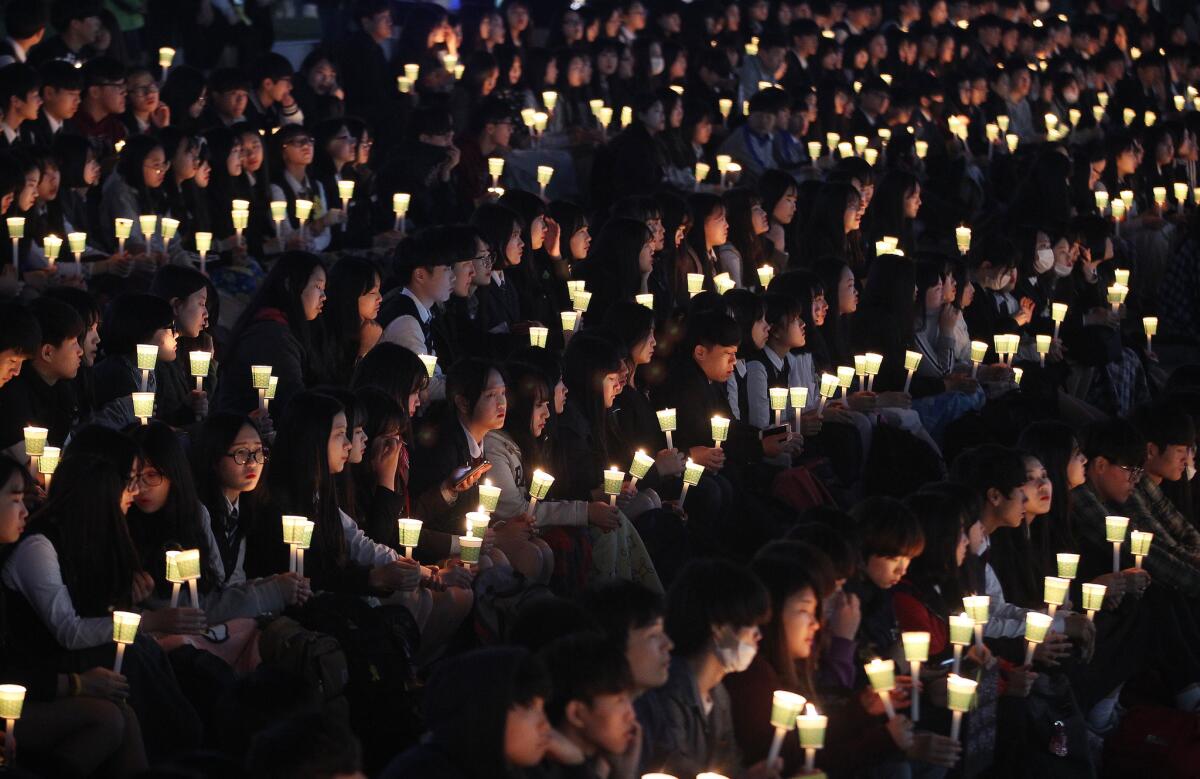Pain and anger in South Korea two years after the Sewol ferry tragedy

High school students hold candles to pay their respects to the victims of the Sewol ferry disaster during a ceremony April 15 on the eve of the sinking’s two-year anniversary in Ansan, South Korea
- Share via
Reporting from Seoul — Two years ago, Kwon Oh-hyun was living a life of rhythm and harmony, working as a singer-songwriter.
He spent weekdays composing music that he sold to production studios; on weekends he performed rousing rock songs live at venues around South Korea.
Then, on April 16, 2014, the Sewol ferry sank off the country’s south coast, resulting in more than 300 deaths. Kwon’s younger brother, Kwon Oh-cheon, was among the many high school students who perished.
Kwon no longer sings the same kinds of songs.
“Before my brother’s death, I was really into upbeat music,” the 28-year-old Kwon said. “But after that, I could only write or perform sad songs.”
The Sewol disaster remains a painful subject in South Korea, and victims’ families are still fighting for an investigation that will determine and explain exactly what happened. The ferry had been en route from Incheon on the country’s northwestern coast to the resort island of Jeju when it sank.
Relatives and friends of the victims won’t forget the sordid details that emerged about the ferry and the company that ran it.
Instead of working to evacuate the sinking ferry, the captain and crew fled on the first rescue ship that came to the scene, and some crewmembers sipped beer while waiting to be rescued. The owner of Cheonghaejin Marine, the company that owned the Sewol, ignored orders to appear for questioning; later, his body was found decomposing in a plum orchard, surrounded by empty liquor bottles.
As the details trickled out, South Korean society united in rage and sorrow, but as the emotional duress dragged on, the sinking became politicized. Right-wing civic groups have accused the victims’ families of milking the spotlight and trying to use the sinking as a pretext to wrest compensation from the government.
Though the ferry’s captain and senior crew members were sentenced to prison terms in a 2014 trial, a group of bereaved families and politicians have continued seeking answers to questions such as how the ferry got permission to leave port dangerously overloaded and why the Coast Guard failed to rescue more passengers. About 170 of the more than 470 people aboard the vessel were rescued.
The victims’ families have maintained that they won’t give up until the complete truth about the sinking has been found, while right-wing groups urge them to give up and go home, arguing that further investigation is a waste of government time and money.
An ad hoc fact-finding committee organized by the government and outside experts from fields including maritime safety has taken statements from the ferry’s crew and Cheonghaejin Marine staff. In June, the committee is scheduled to put forth a bill in parliament mandating further investigation into how the ferry sank.
In the meantime, filmmaker Kim Dong-bin timed the release of his documentary “Upside Down” to coincide with the sinking’s second anniversary. The film tells the story of four high school students who died in the sinking, through interviews with their fathers.
Kim said he was motivated to make the film in part by how the Sewol has become a divisive subject in South Korea. “There is this negative stigma surrounding the Sewol. Unless they feel it on their skin, I find it hard to motivate people to care about the tragedy,” Kim wrote in an email.
Kwon is among those who have no trouble caring. He still thinks of the morning he heard the Sewol was in distress, knowing that Kwon Oh-cheon and his classmates were aboard on a school trip to a holiday island. Kwon rushed to the scene, arriving in time to identify his brother’s body when divers recovered the teenager from the ferry’s hull, the second confirmed casualty.
In the months after the sinking, Kwon would vomit after eating anything, even sometimes after drinking water, and lost more than 50 pounds over a period of six months.
Doctors told Kwon he had a form of bulimia caused by guilt over being alive and able to enjoy food, while his brother was dead. He was encouraged to attend regular counseling, but declined, saying he would rather his wounds remained raw.
“The pain I feel over my brother’s death is my last connection to him,” Kwon said. “If I lose this anguish, I will have fully lost him.”
Kwon and others maintain a sit-in site in Gwanghwamun Square in the center of the South Korean capital, where they have set up temporary housing and hung sparsely worded, emotional messages, including, “Together to the end” and “Let’s reveal the truth of the Sewol.” They take shifts staying round-the-clock at the site, passing out pamphlets with information on the sinking.
On a hazy, early spring evening, as the city buzzed with families out to see blooming cherry blossoms, the families and their supporters held a concert in Gwanghwamun Square, singing songs and drawing pictures in honor of those who died.
Kim Min-soo, a 23-year-old college senior who felt sympathy for those who lost loved ones, knelt on the concrete, using pastels to draw a picture of the Sewol ferry on top of tall blue waves.
An accompanying message read: “We won’t forget.”
Borowiec is a special correspondent.
More to Read
Sign up for Essential California
The most important California stories and recommendations in your inbox every morning.
You may occasionally receive promotional content from the Los Angeles Times.










